Inside: Check out easy, affordable ways to build fences that fit your style and budget. These ideas help you create privacy and improve your outdoor space.
If you want to add a fence without breaking the bank, you’re in the right place. You’ll find simple, low-cost DIY fence ideas that just about anyone can try to make their yard look better and more private.
Maybe you want something rustic, modern, or super green with plants. There are plenty of options to try out.

1. DIY pallet fence
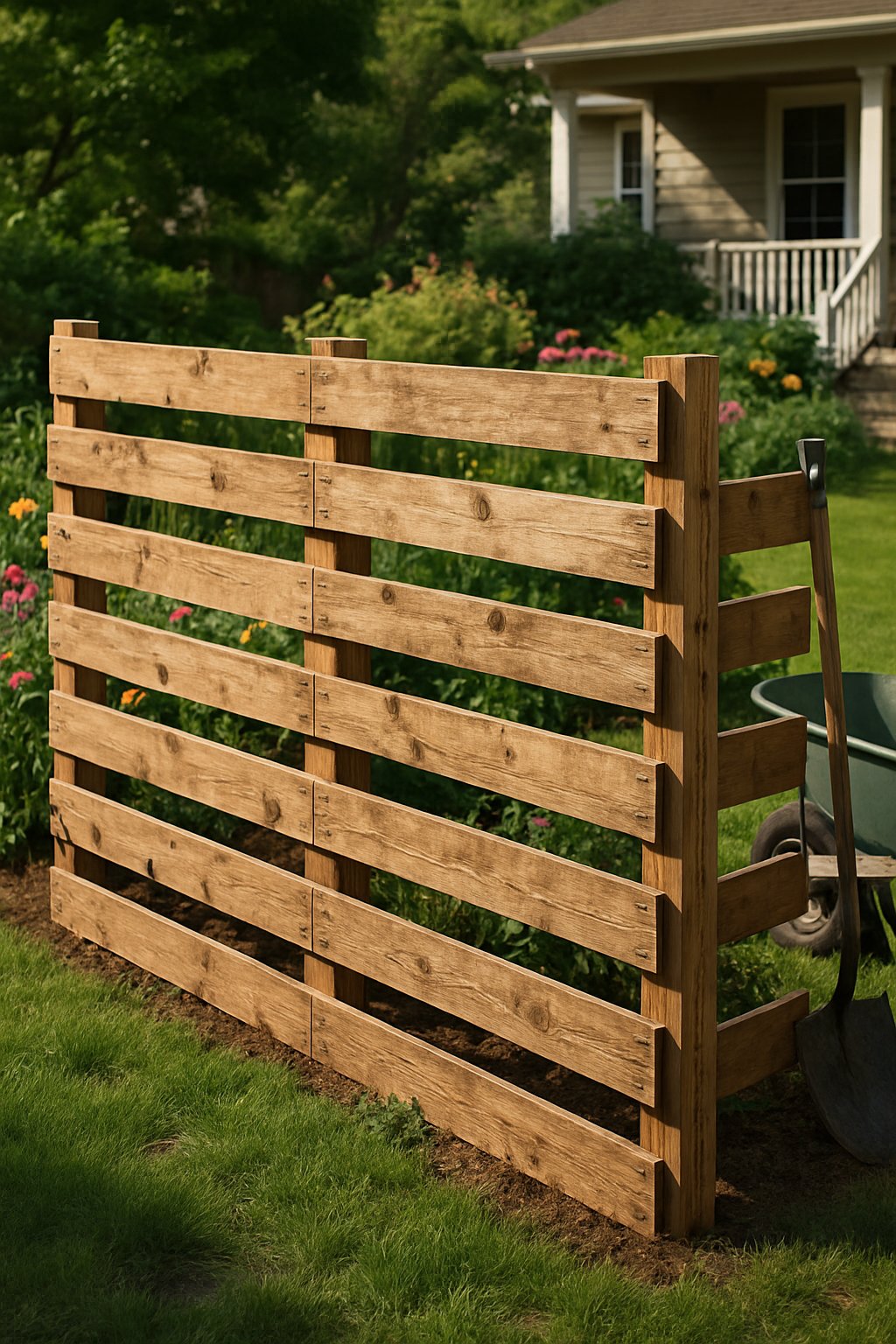
A pallet fence gives you a low-cost, sturdy barrier around your yard or garden. You can usually find free or cheap wood pallets at stores or warehouses.
Even if you’ve never built anything, you can put these fences together easily. Just stand the pallets upright and secure them to posts or even straight into the ground.
Paint or stain the pallets to match your vibe. They add privacy and help keep pets or kids safe in your yard.
You can play with the layout—add a gate, mix up pallet colors, whatever you like. It’s flexible for dividing spaces or protecting your plants.
Pallet fences work for odd-shaped yards since you can cut and arrange them to fit just right.
Expert Tip from MrPlanter: “Go for heat-treated pallets, not chemically treated ones, for safety. Sand the wood before painting to prevent splinters and help the paint stick.”
2. Rustic split rail fence

A split rail fence is one of the easiest and most affordable fences you can build. It gives your yard a simple, ranch-style look that really fits rustic or farmhouse themes.
You only need a few materials: wooden rails and posts. Set the posts into the ground, then fit the rails between them—usually, you don’t even need nails.
This fence is great for marking boundaries or adding charm, but it doesn’t give full privacy. It lets light and air flow through while still defining your space.
Use old wood or buy new rails, whatever works for your budget. The wood weathers over time, which actually adds to the rustic look.
A split rail fence also looks good around gardens or as a decorative border.
Expert Tip from MrPlanter: “Pick pressure-treated wood to resist rot and pests. Set posts deep for better stability.”
3. Horizontal wooden slat fence
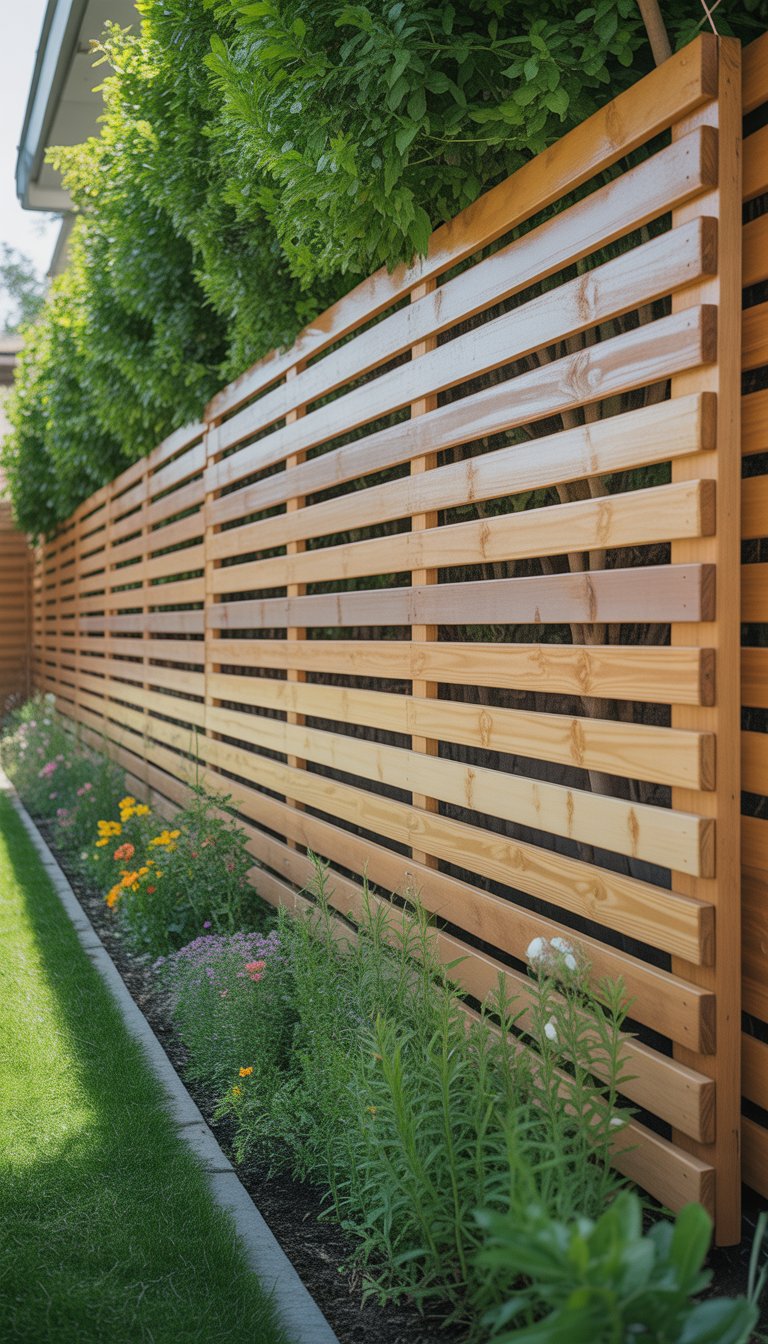
A horizontal wooden slat fence adds privacy and looks stylish without being complicated. Use affordable wood like pine or cedar to keep costs down.
The slats run horizontally, giving a modern look that works in lots of outdoor spaces.
You can adjust the spacing between slats—make it tight for more privacy or leave gaps for a lighter feel. Install supports behind the slats to keep everything strong and straight.
Paint or stain the wood to match your home or garden style. Building this fence is easier with a kit, but you can make one from scratch with basic tools too.
It works well for garden borders or dividing spaces without blocking all the light.
Expert Tip from MrPlanter: “Seal your wood with a weatherproof finish to protect it from moisture. Natural colors help your fence blend into the landscape.”
4. Decorative wire panel fence
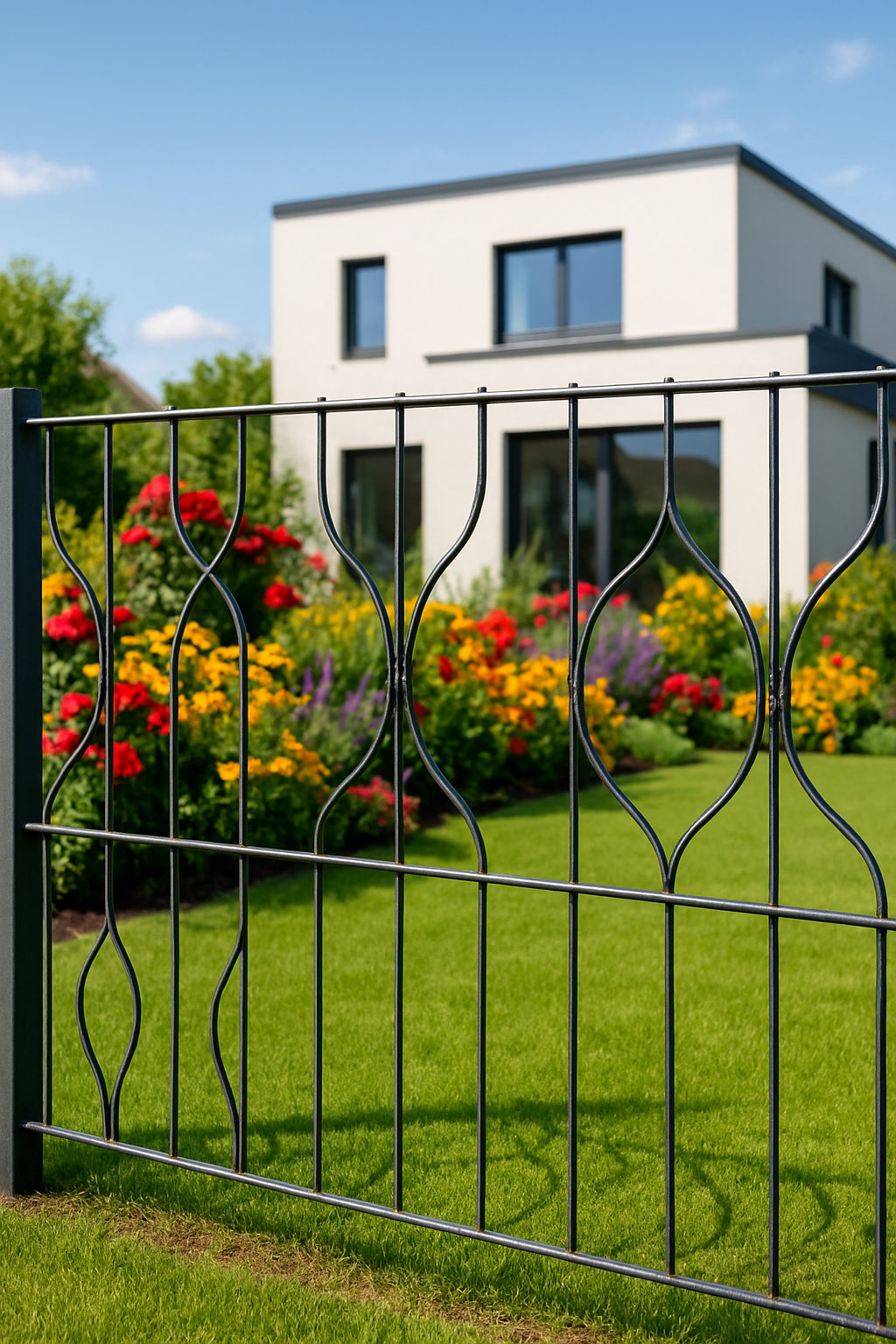
A decorative wire panel fence is an affordable way to add both style and function. You can use cattle panels or hog wire for a strong, open design that lets in plenty of light.
These fences work great for gardens or pet enclosures. You can easily customize the height and length to fit your space.
Add wooden or metal posts to keep the panels sturdy. Paint or stain the posts for a finished look.
This fence is low maintenance and even lets plants grow through if you want a natural vibe. Hang string lights or decorations for a more inviting feel.
Expert Tip from MrPlanter: “Use a level to set posts straight. Treat metal panels with rust-resistant spray so they last longer.”
5. Board and batten wooden fence
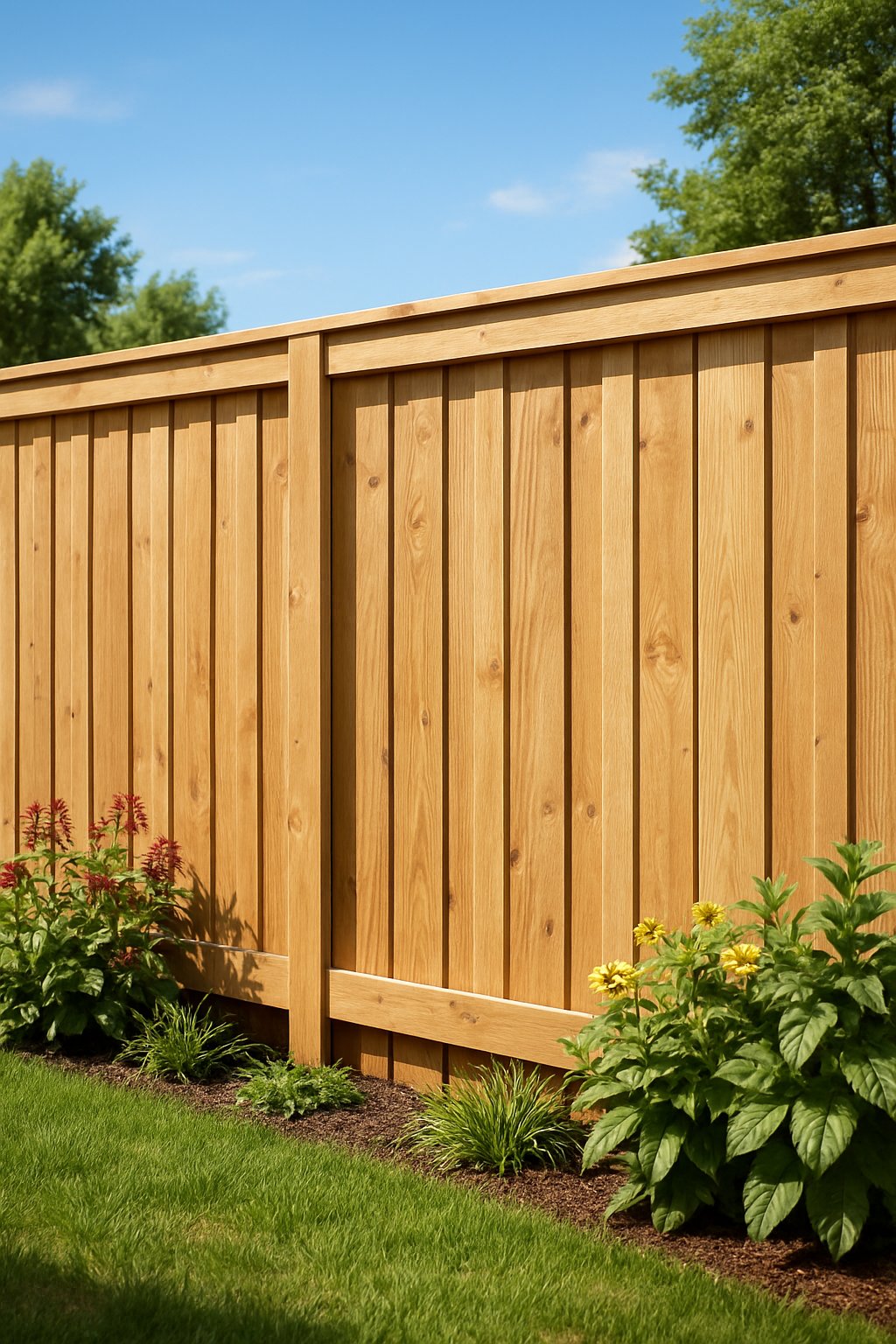
A board and batten fence uses wide boards placed vertically with narrow battens covering the gaps. This gives your yard a clean, classic look and adds privacy without making the fence feel too heavy.
Build this fence with simple wood like cedar or pine—they’re affordable and last a long time. Set the posts at least 2 feet deep to keep the fence stable.
Paint or stain the wood to protect it from the weather and help it last. This style works well if you want a mix of privacy and charm in your yard.
Expert Tip from MrPlanter: “Use treated wood for the posts to prevent rot. Space battens evenly to block gaps and improve privacy.”
6. Board and lattice fence with climbing plants
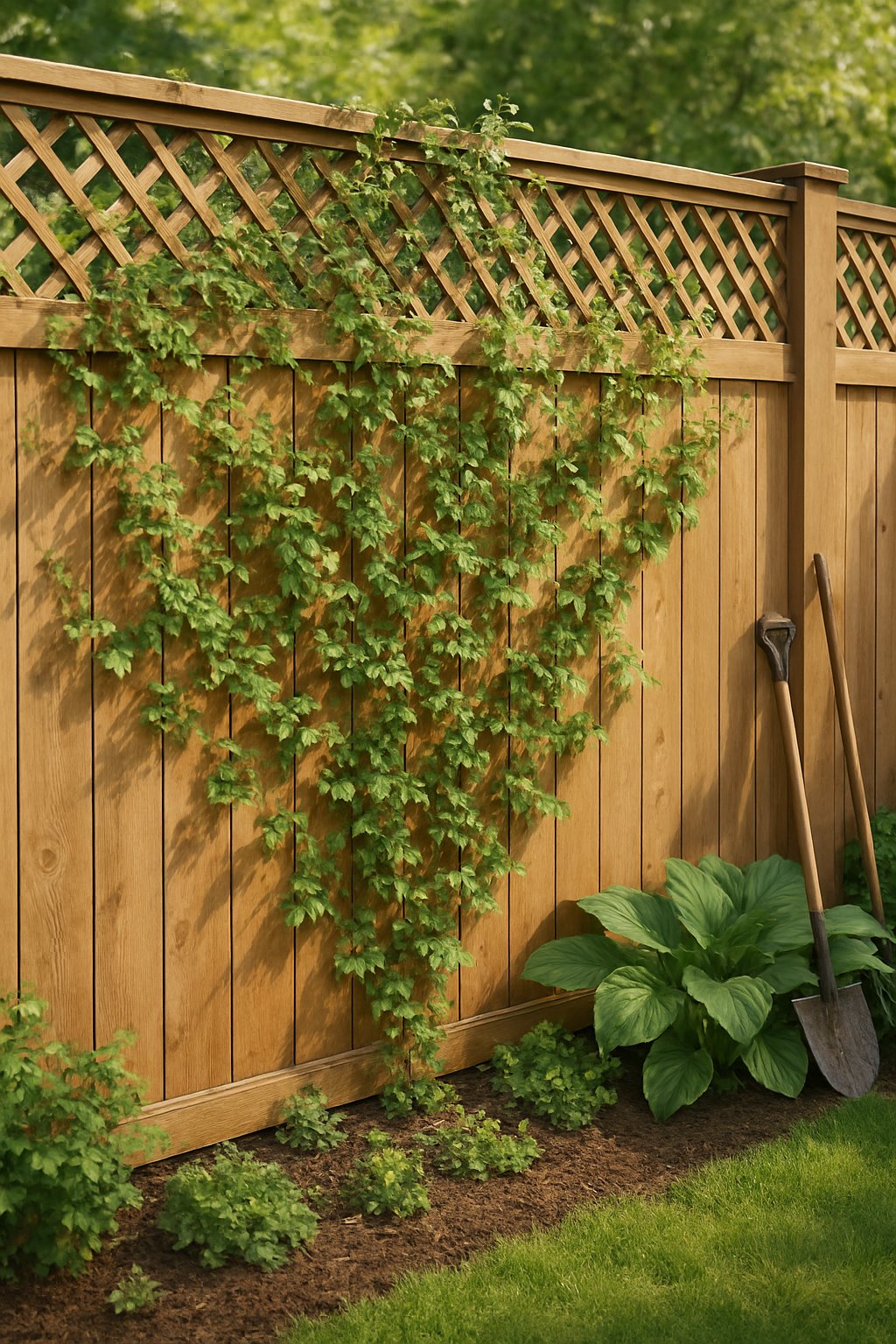
A board and lattice fence gives you solid privacy with a decorative top section. The lattice lets your climbing plants grow up and adds natural beauty.
Use simple wood boards for the base and attach lattice panels to the top. Pick climbing plants like clematis, jasmine, or ivy to cover the lattice.
These plants bring color and texture and soften the look of the fence. They also create shade and can block wind.
This fence style is budget-friendly. Buy inexpensive lumber and lattice panels, or reuse materials if you can.
Adding climbing plants is low-cost and helps keep the fence cooler, which can make it last longer.
Expert Tip from MrPlanter: “Pick fast-growing, hardy climbers for quick coverage. Gently train the plants so they spread evenly across the lattice.”
7. Privacy fence with recycled wood
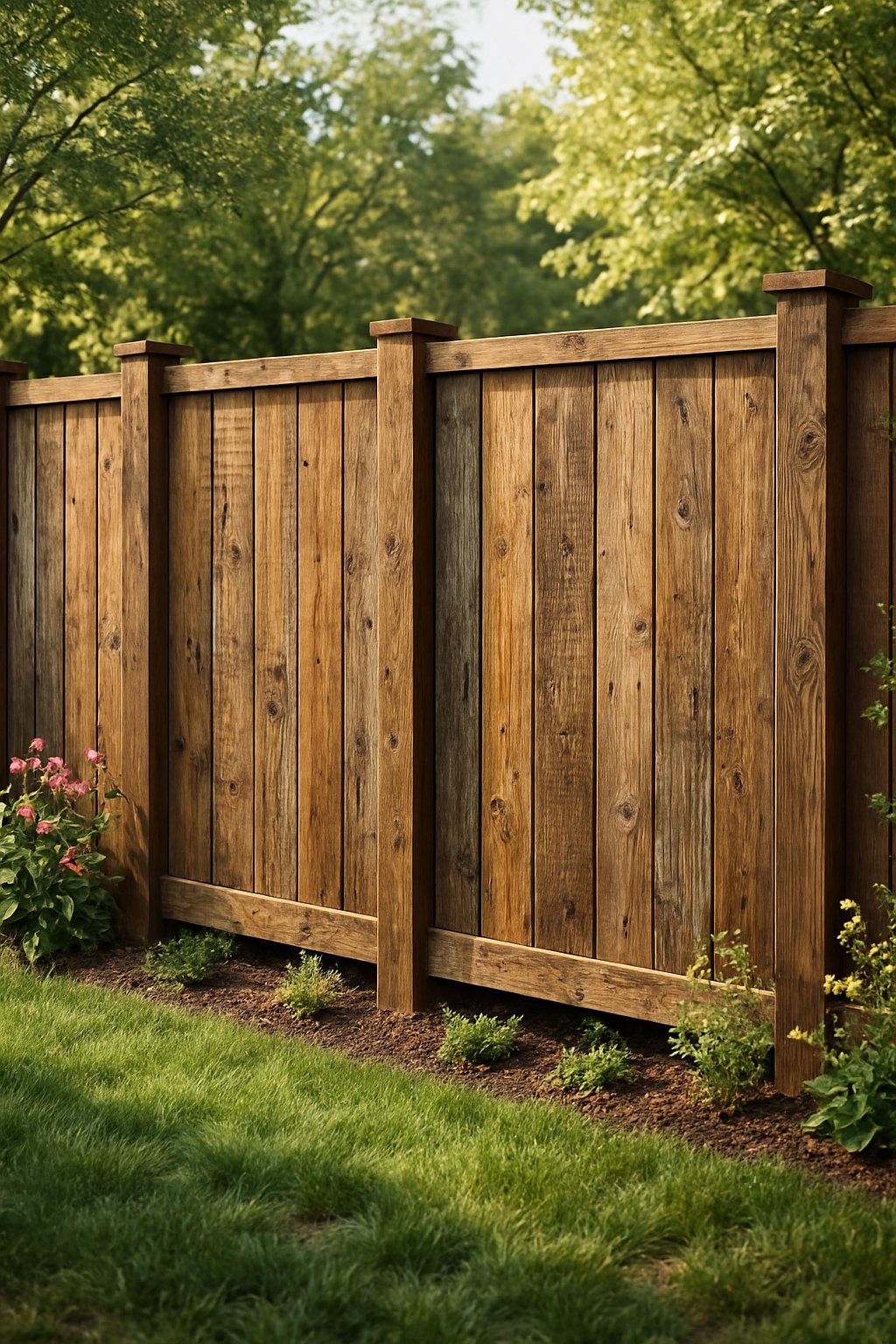
Using recycled wood for a privacy fence saves money and helps the planet. Look for old pallets, barn wood, or leftover planks from other projects.
These materials often have a cool, unique look that adds character. Before building, check the wood for damage—rot or insect holes can be a problem.
Sand down rough spots so you don’t get splinters. Paint or stain the wood to protect it and match your yard’s style.
Recycled wood fences are easy to customize. Mix different wood types or leave some gaps if you want a more modern feel.
This is a great option if you want a budget-friendly, handmade fence that stands out from the usual.
Expert Tip from MrPlanter: “Pick sturdy recycled wood and treat it to last longer outside. Double-check for old nails or screws before building for safety.”
8. Chicken wire and wood frame fence

A chicken wire and wood frame fence is simple and affordable. Build a wooden frame first, then attach chicken wire to it.
This fence works well for gardens or keeping small animals in or out. Use treated wood so it won’t rot and will last longer.
Chicken wire is light but strong enough to protect your plants or pets. You can easily cut the wire to fit your frame.
The wooden frame gives the fence stability and makes installation a breeze. Paint or stain the wood to match your yard style.
This design is easy to move if you want a portable fence. You’ll need staples or nails to secure the wire to the wood.
Make sure you pull the wire tight so it won’t sag. The height depends on what you need to keep in or out.
Expert Tip from MrPlanter: “Stretch the wire before attaching it to avoid gaps. A hammer stapler speeds up securing the wire and avoids damage.”
9. Painted picket fence
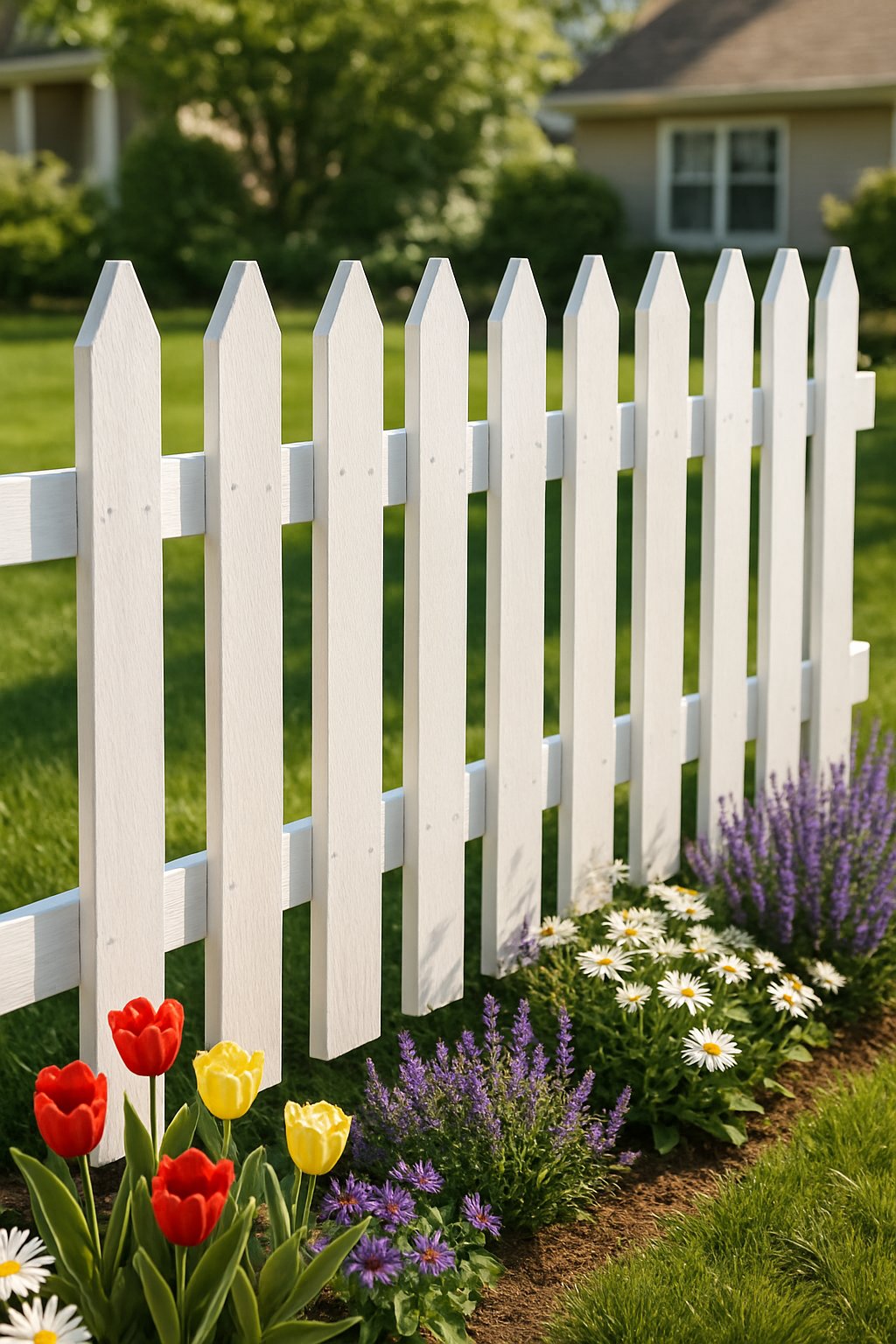
Painting a picket fence is an easy way to freshen up your yard without spending much. Go classic with white or try bold, bright colors to make your fence pop.
Before painting, clean the fence and sand any rough spots. This helps the paint stick and last longer.
Use exterior paint made for wood to protect your fence from the weather. Try out different colors to match your garden or house.
Light colors can make your space feel bigger, while dark colors add a modern touch. If you’re feeling creative, paint patterns or designs for a unique look.
Regular touch-ups keep your fence looking good. Painting also helps prevent wood damage from the sun and rain.
Expert Tip from MrPlanter: “Pick a high-quality, weather-resistant paint so you spend less time on repairs. Use a paint sprayer for a faster, more even coat.”
10. Faux hedge fence
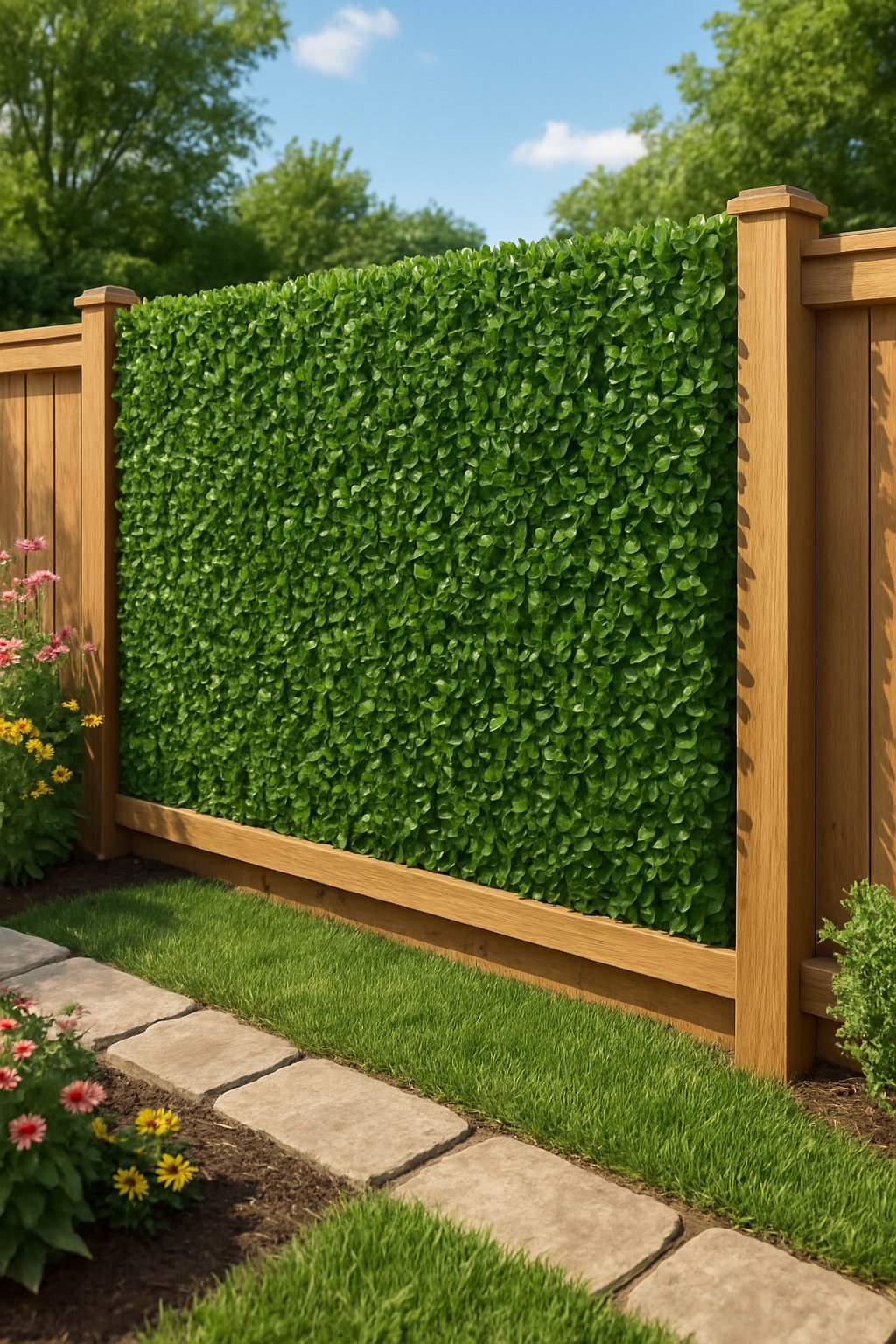
A faux hedge fence gives your yard a clean, green look—no real plants needed. Just attach artificial hedge panels to an existing fence like chain link or wood.
Start by measuring the area you want to cover so you know how many panels to buy. Most panels attach with zip ties or hooks, which makes installation quick.
These fences block views for privacy and add a natural feel to your space. They need almost no maintenance compared to live hedges.
You can even mix faux panels with real plants for a fuller look. Trim real hedges to fit behind or around them.
Expert Tip from MrPlanter: “Secure panels tightly to prevent wind damage. Pick UV-protected panels so the color lasts longer.”
11. Salvaged yard fence with reclaimed wood

Building a fence with reclaimed wood is a smart way to save money. You can hunt down old barn wood or grab scraps from salvage yards.
These pieces usually have a lot of character—knots, colors, and weathering—so your fence ends up looking one-of-a-kind.
Start by gathering enough wood and making sure it’s clean and dry. Measure your space so you don’t come up short.
Mix different wood types for a rustic style or stick to one kind if you want a neater look.
Check each board for nails or screws before you get to work. Sand down any rough edges so you don’t get splinters.
You can paint or seal the wood to help it last longer and keep bugs away.
If you treat the wood right, this fence can last for years. You’ll save cash and help the environment by reusing materials.
Expert Tip from MrPlanter: “Always inspect reclaimed wood carefully for damage before use. Seal your fence yearly to keep it lasting longer.”
12. Mesh wire fence with wooden posts
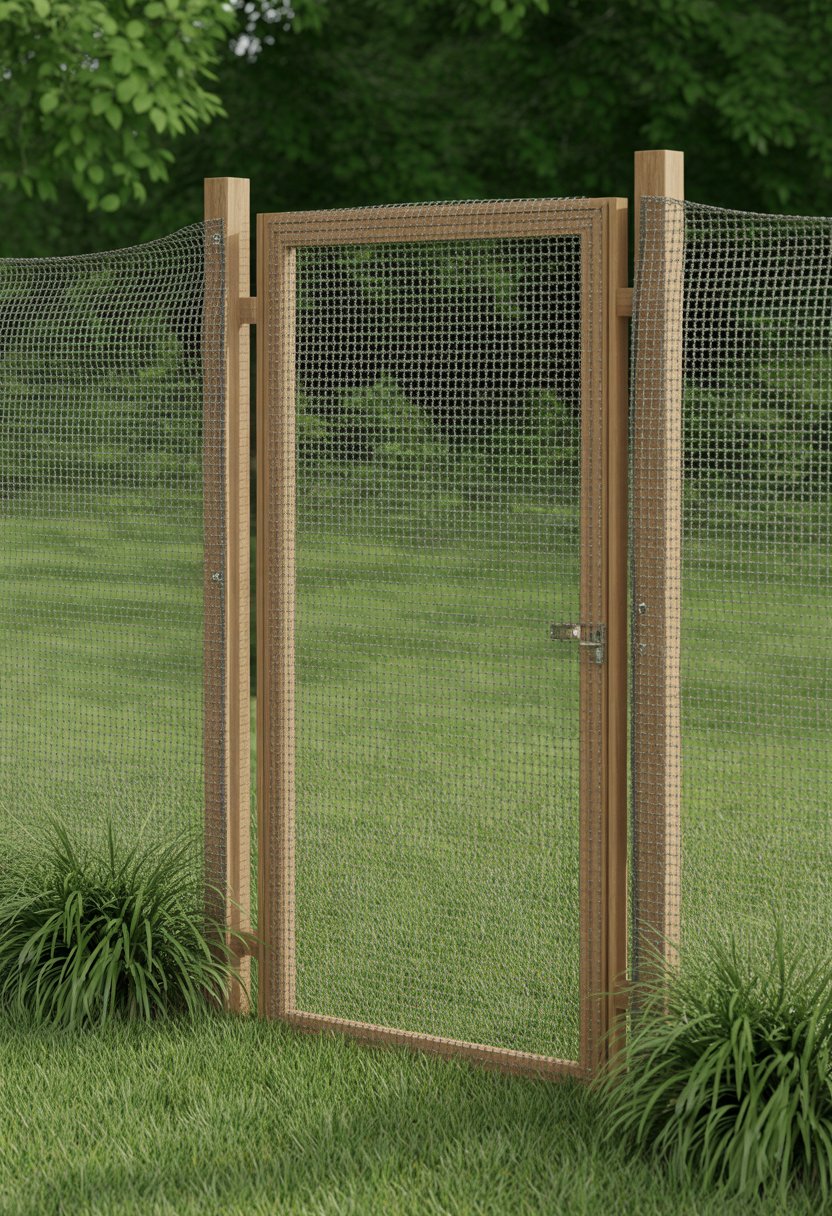
Mesh wire fences with wooden posts are a classic, budget-friendly way to secure your yard or garden. First, set your wooden posts deep into the ground so the fence stays sturdy.
Attach the mesh wire to the posts using staples or wire ties. Pull the mesh tight so it doesn’t sag.
Pick your mesh size based on whether you want to keep pets in or critters out. This fence style is easy to build and it’s great for letting in sunlight and air.
If you need a gate, just frame one with wood and add mesh. That way, getting in and out is a breeze.
Expert Tip from MrPlanter: “Use treated wood for longer-lasting posts. Tighten the mesh every few months to keep the fence sturdy.”
13. Classic hurdle fence panels

Classic hurdle fence panels use woven sticks or thin branches for a natural, rustic vibe. They’re simple to build and you don’t need fancy tools.
Weave hazel, willow, or any flexible wood to make the panels. They’re lightweight but tough enough to keep small animals away.
You can move or reuse hurdle panels if you need to. Just fix them between wooden posts and you’re set.
These fences blend right in with your plants and flowers. If you want something budget-friendly with handmade charm, hurdle panels are hard to beat.
Expert Tip from MrPlanter: “Use green willow for easier weaving and better flexibility. Treat the wood with a natural preservative to make your fence last longer outdoors.”
14. Tall planter box fence
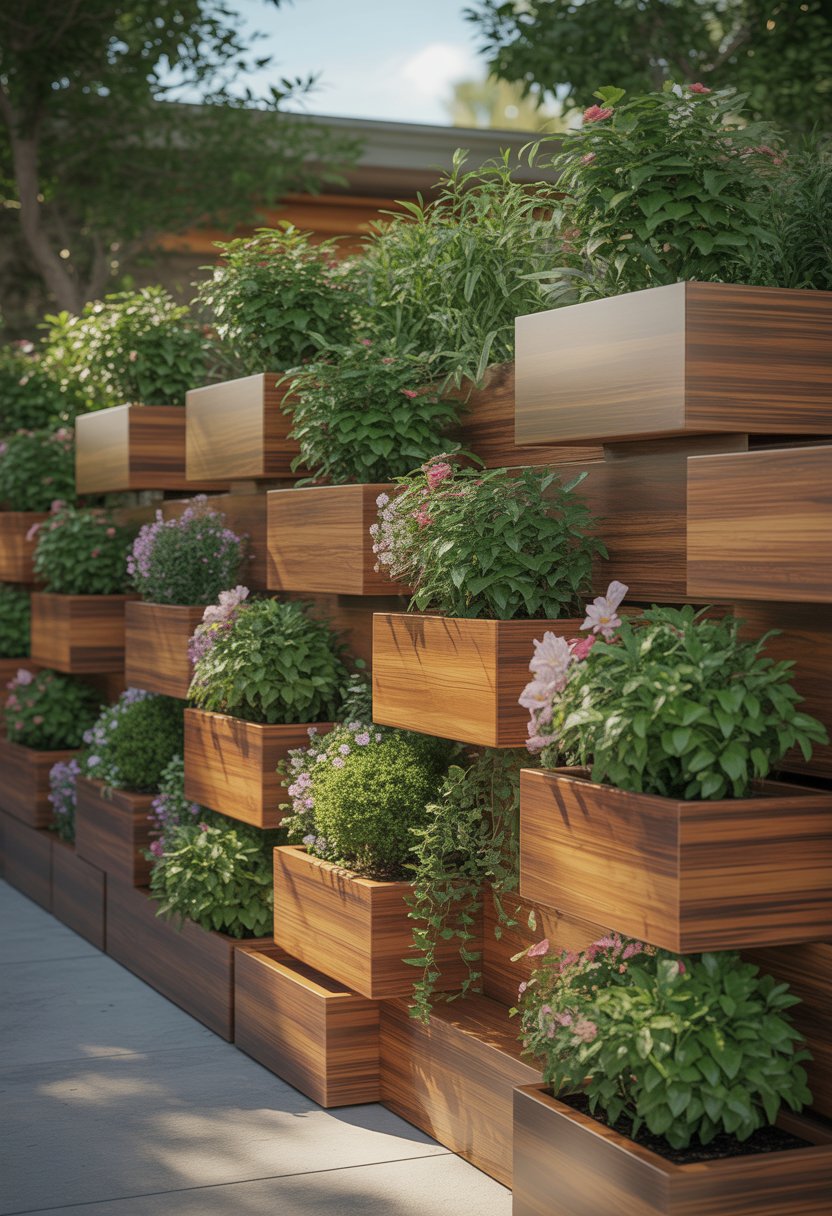
A tall planter box fence gives you privacy and a spot to grow flowers or small plants. You can build it with wood pickets or cedar boards for extra durability.
The height helps block neighbors’ views or street noise. Choose plants that don’t need deep soil and will thrive in containers.
It’s pretty straightforward—stack the planter boxes and secure them together. Add lattice or slats on top if you want more height or style.
It’s a smart way to save space and boost your outdoor look.
Expert Tip from MrPlanter: “Use rot-resistant wood like cedar to make your planter fence last longer. Drill drainage holes to keep plants healthy and prevent water damage.”
15. PVC pipe project fence

PVC pipe works surprisingly well for a simple fence. It’s cheap, light, and easy to cut or connect in any shape or height you want.
This kind of fence is great for garden borders or small enclosures. Just grab a saw, drill, and some connectors—you don’t need much else.
PVC won’t rust or rot, so it’s made to last outside. You can paint the pipes to match your yard or keep them white for a crisp look.
Add wood boards between the pipes if you want more style or strength. If you ever want a new design, it’s easy to move or change the fence later.
Just remember to secure the posts well so things don’t wobble.
Expert Tip from MrPlanter: “Use primer before painting PVC for better paint stickiness. Always seal pipe ends to stop water from getting inside.”
16. Fence with recycled pallets and wire mesh
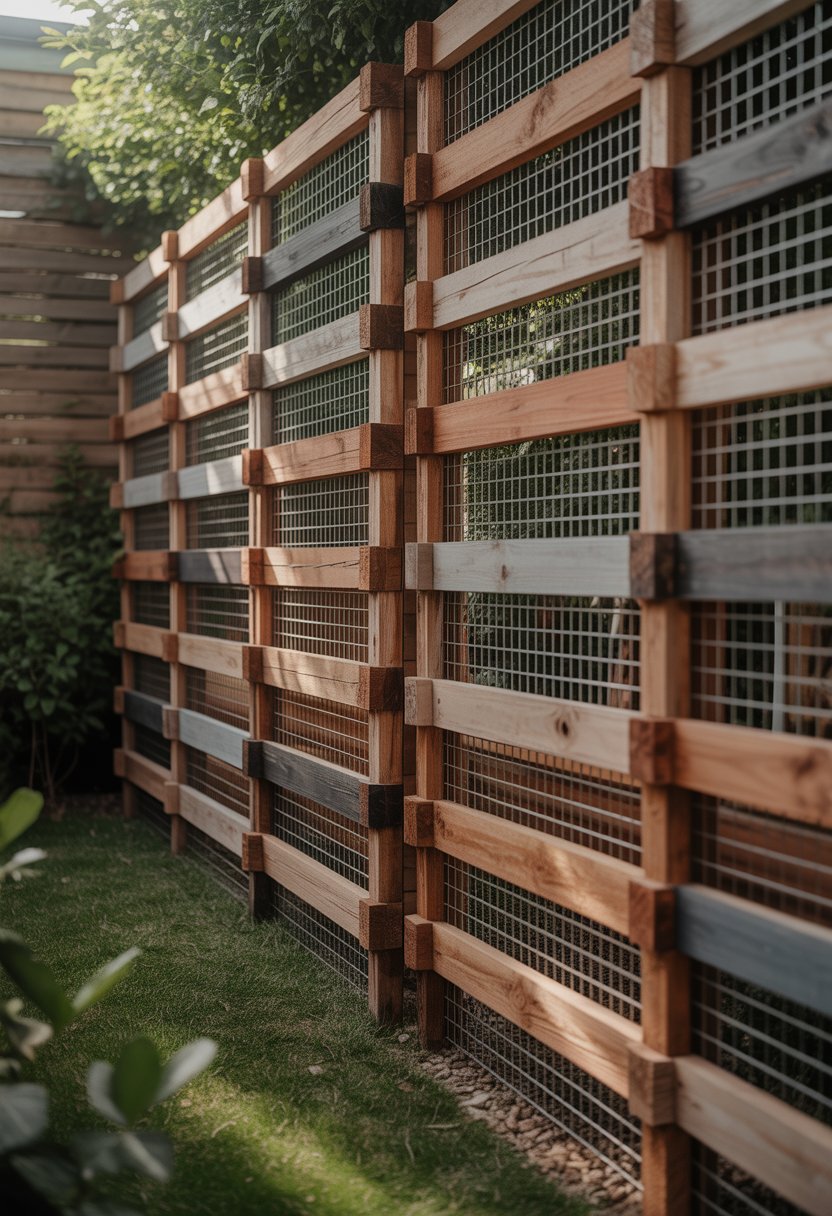
Building a fence from recycled pallets and wire mesh is both strong and budget-friendly. Stand the pallets up vertically to form your frame.
Attach wire mesh behind or between the pallets for extra security and to keep out small animals.
This fence is easy to put together and fix if something goes wrong. You can often find pallets for free or cheap, which keeps your costs down.
The wire mesh adds strength but still lets in light and air. Leave the pallets natural for a rustic look or paint them to match your style.
This setup works great around gardens or anywhere you want a mix of openness and protection.
Expert Tip from MrPlanter: “Choose pallets that are in good shape and not chemically treated. Use galvanized wire mesh to avoid rust and make your fence last longer.”
17. Budget-friendly vinyl fence installation
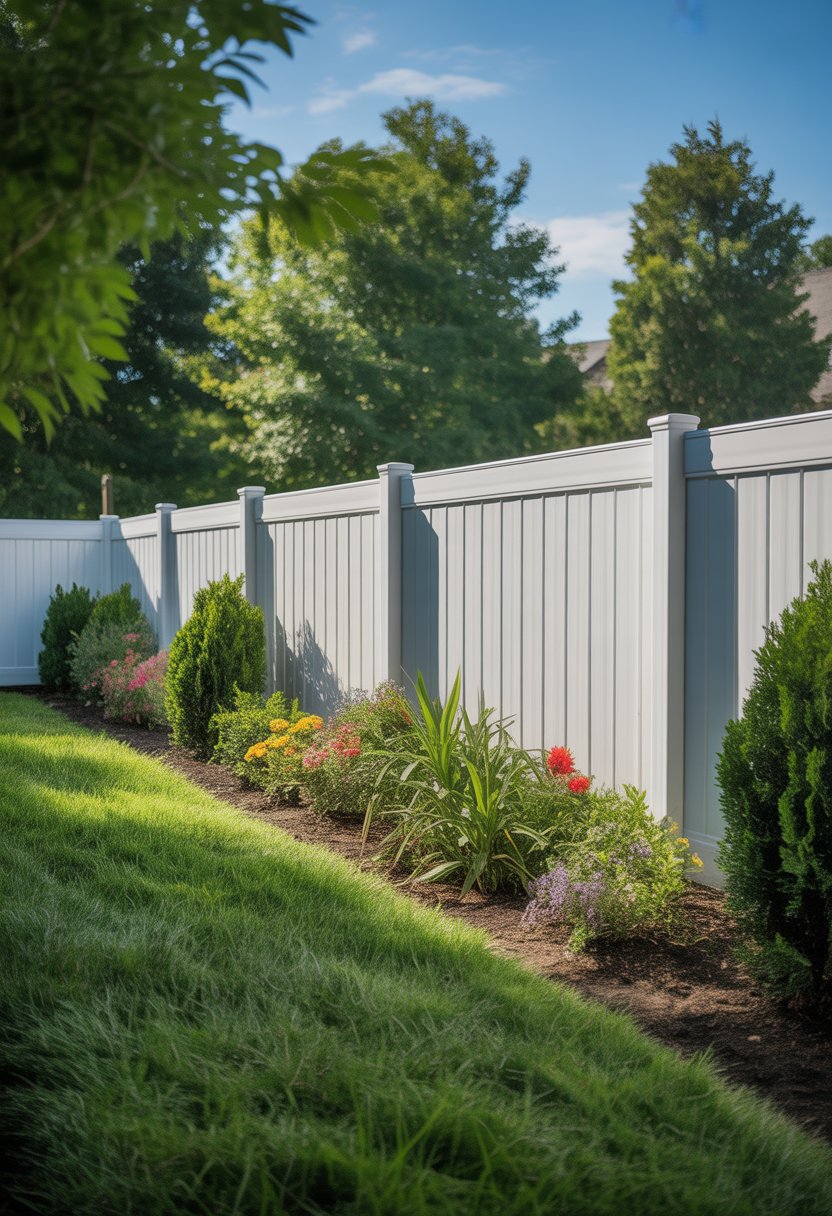
Vinyl fences can look sharp and last for years, and you don’t have to spend a fortune. Pick up vinyl fence kits—they come with all the parts you’ll need.
Kits make installation way easier, even if you’re not a pro. Measure your yard carefully so you don’t buy too much material.
Use basic tools like a post hole digger and a level to set your posts straight. Good post placement keeps your fence steady.
Mix in cheaper vinyl panels with recycled posts if you want to cut costs. Follow the kit’s instructions and take your time with the first posts—they set the tone for the whole fence.
Vinyl fences need almost no upkeep, which saves you money down the road. Just wash with soap and water now and then to keep it looking fresh.
Expert Tip from MrPlanter: “Use a string line to keep your fence straight during installation. This simple step makes the whole project look more professional.”
18. Fence with repurposed doors
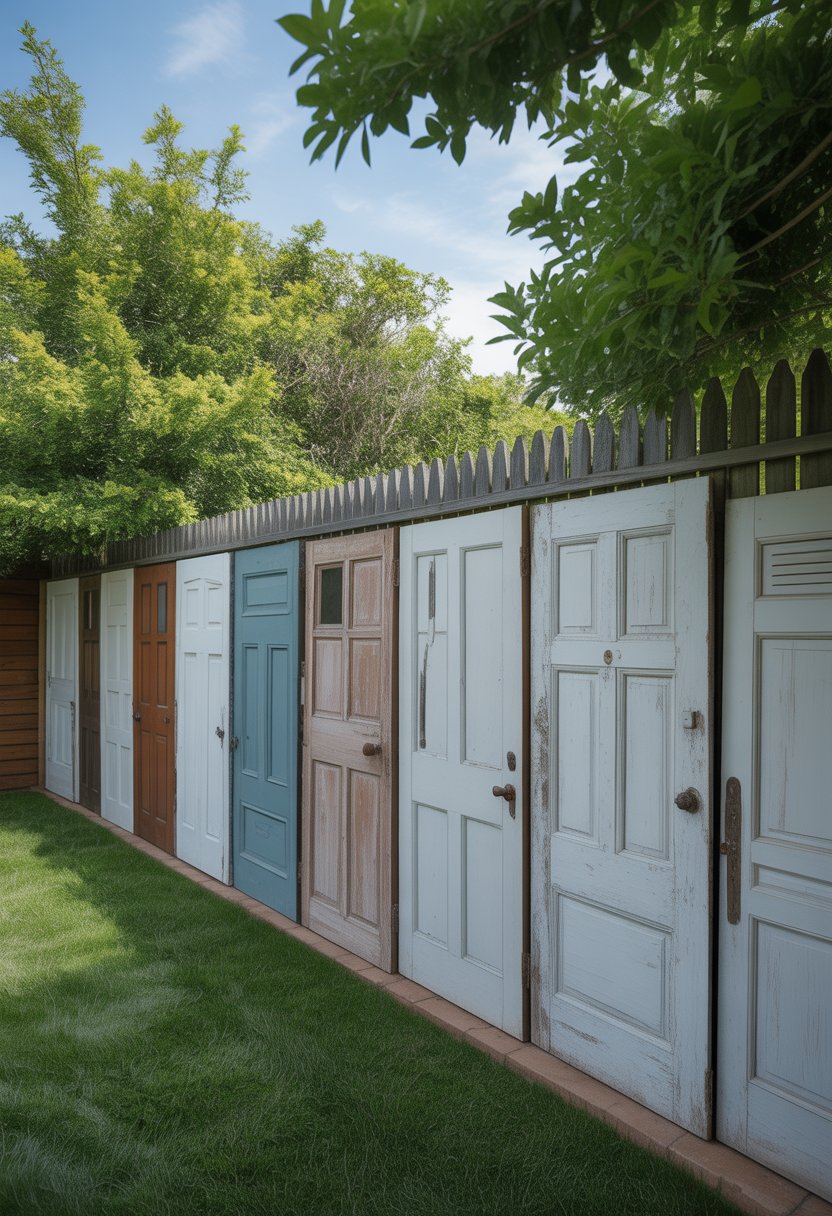
Repurposing old doors into a fence is such a fun, budget-friendly idea. You can score doors at thrift shops, yard sales, or maybe even your own garage.
Each door brings its own story and adds a vintage touch to your yard. Mix and match styles or colors for a quirky, eclectic vibe.
Doors already stand up well and often have hardware you can reuse. You might need to fix them up or weatherproof them for outdoor use.
A coat of sealant or paint protects against rain and sun. Since doors come in all heights, you can keep things varied or trim them to match.
Skip the gate—just swing open a door for entry. This fence is perfect for privacy and doesn’t take fancy skills.
Just make sure you secure each door with screws or nails so nothing tips over.
Expert Tip from MrPlanter: “Use weather-resistant paint to extend the life of your door fence. Check doors regularly for damage and fix them early to keep your fence looking good.”
19. Split rail fence with wire mesh
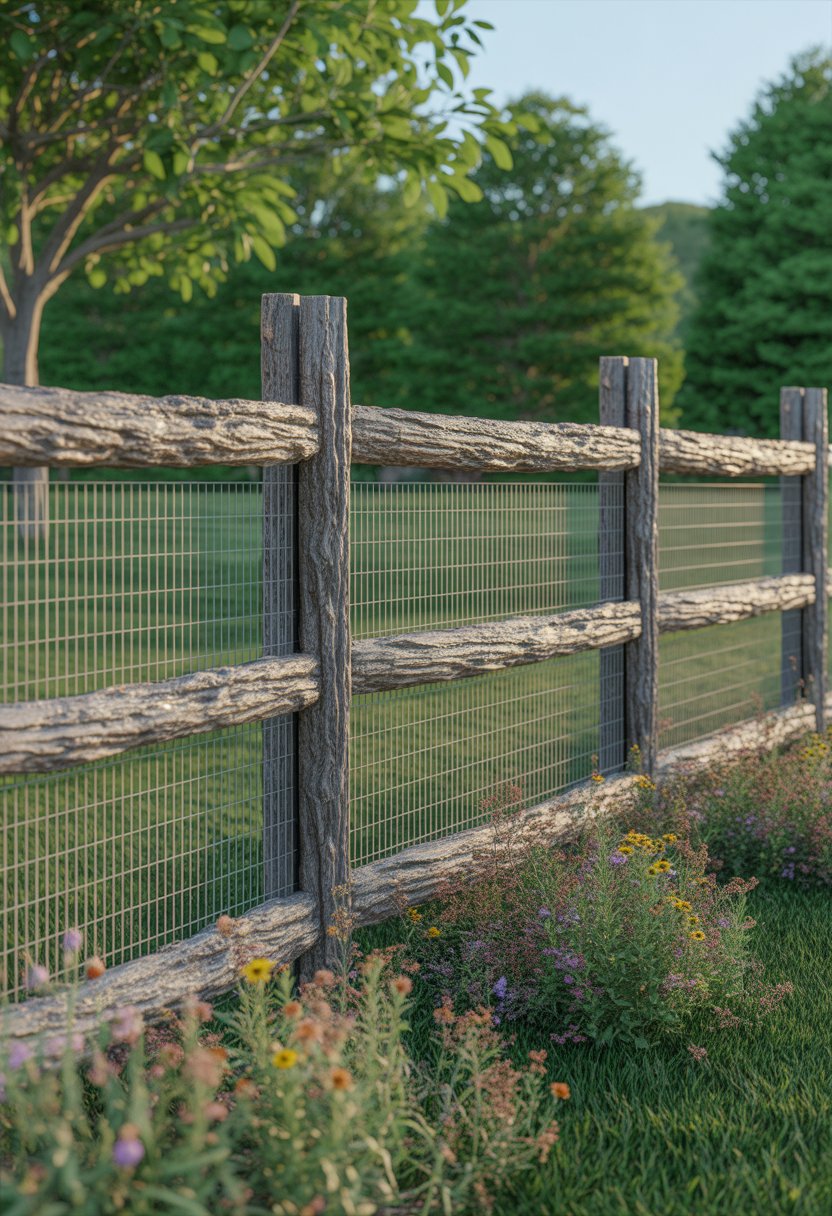
Split rail fences with wire mesh are a classic way to keep animals in and still get that rustic look. Use two or three rails depending on how sturdy you want it.
Set your posts deep and use concrete footings so they don’t rot or shift. Attach rails between the posts, making sure everything lines up.
Staple wire mesh to the rails using galvanized staples—about every foot works well. The mesh keeps smaller animals from squeezing through.
This fence is ideal if you want a natural look but need to keep dogs or livestock safe. Plus, it uses less wood than a full board fence, so you save money.
Expert Tip from MrPlanter: “Always use treated wood or cedar for your rails to extend the life of your fence. Fasten the wire mesh tightly to avoid sagging over time.”
20. Fence with painted wooden crates

You can make a unique fence by stacking wooden crates and painting them in fun colors. It’s a playful, creative look that doesn’t cost much.
The crates give you built-in shelves for small plants or decorations. Your fence turns into something useful and eye-catching.
Seal the wood before painting to protect it from the weather. This helps your fence last longer.
Arrange the crates tall, short, or staggered—whatever fits your space. It’s easy to move things around if you want a new look later.
If you score crates for free or cheap, you’ll keep your budget super low. It’s a clever way to recycle and add style.
Expert Tip from MrPlanter: “Use outdoor paint for better weather protection. Also, line the crates with plastic if you want to add plants to avoid water damage.”
21. Cheap concrete textured fence
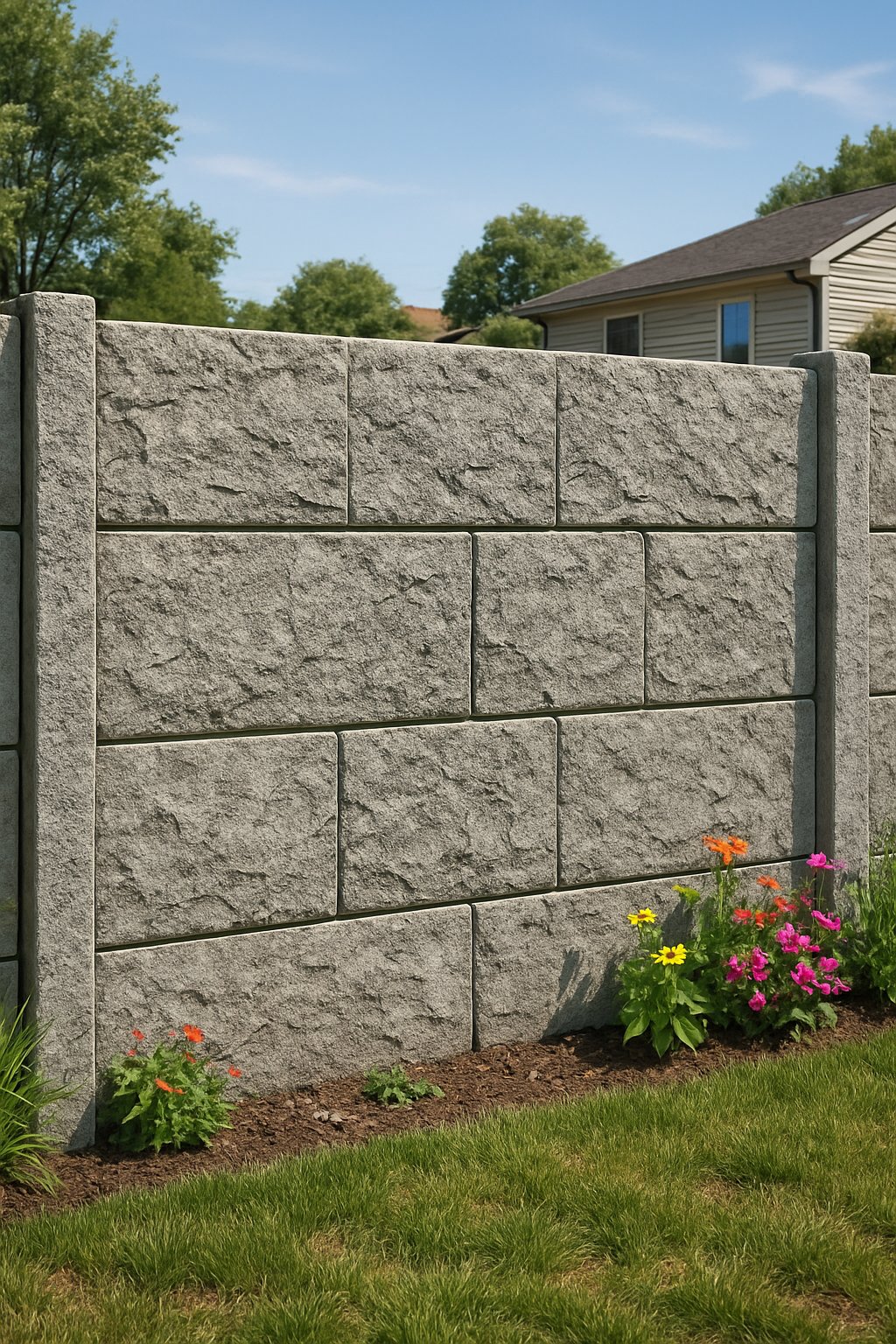
A concrete textured fence offers solid privacy without breaking the bank. You can create cool patterns or textures by using molds or stamps while the concrete is still wet.
Concrete fences last a long time and barely need maintenance. Paint them later if you want to match your yard’s style.
Use recycled concrete or basic molds to keep costs low. If you want extra privacy, plant vines or shrubs nearby to soften the look.
Expert Tip from MrPlanter: “Use rubber mats with patterns as molds to make your own textured panels cheaply. Let your concrete cure slowly for a stronger, crack-free fence.”
22. DIY fence using fence pickets and stakes
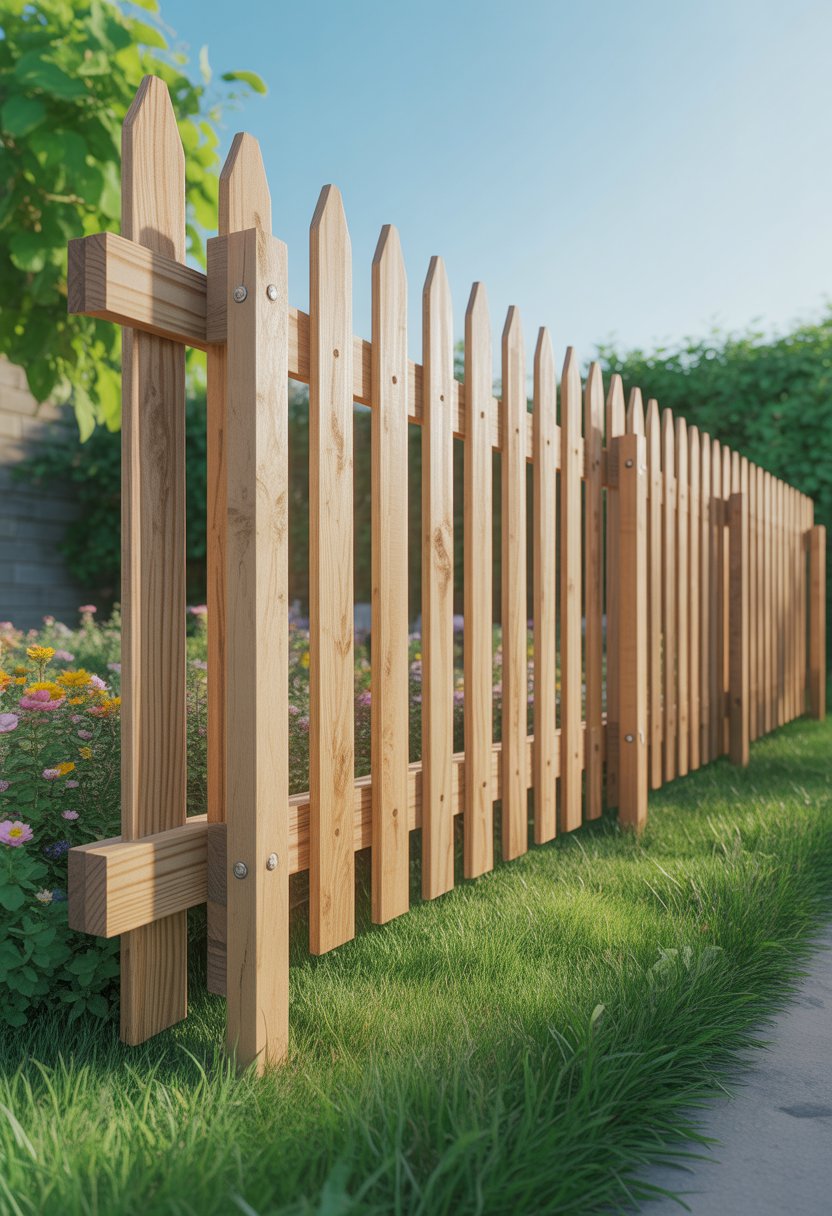
You can build a simple fence with wood fence pickets and stakes. Just get some pickets and wooden stakes—buy them or maybe recycle what you have.
Lay out where you want the fence, and space the stakes evenly along that line. Hammer the stakes into the ground first, one by one.
Then, grab the pickets and attach them to the stakes using nails or screws. If you want more privacy, keep the pickets close together, but for a lighter look, leave some gaps.
This fence uses basic materials, so it’s really affordable. You can tweak the height easily—just trim the pickets or stack more on.
Go ahead and paint or stain the wood if you like, since that helps it last longer in the weather. People often use this fence for gardens or marking property lines.
It’s honestly a quick way to make a nice-looking barrier without spending a ton.
Expert Tip from MrPlanter: “Use pressure-treated wood for longer fence life outdoors. Pre-drill holes to avoid splitting the pickets when nailing.”
23. Decorative gate made from scrap wood
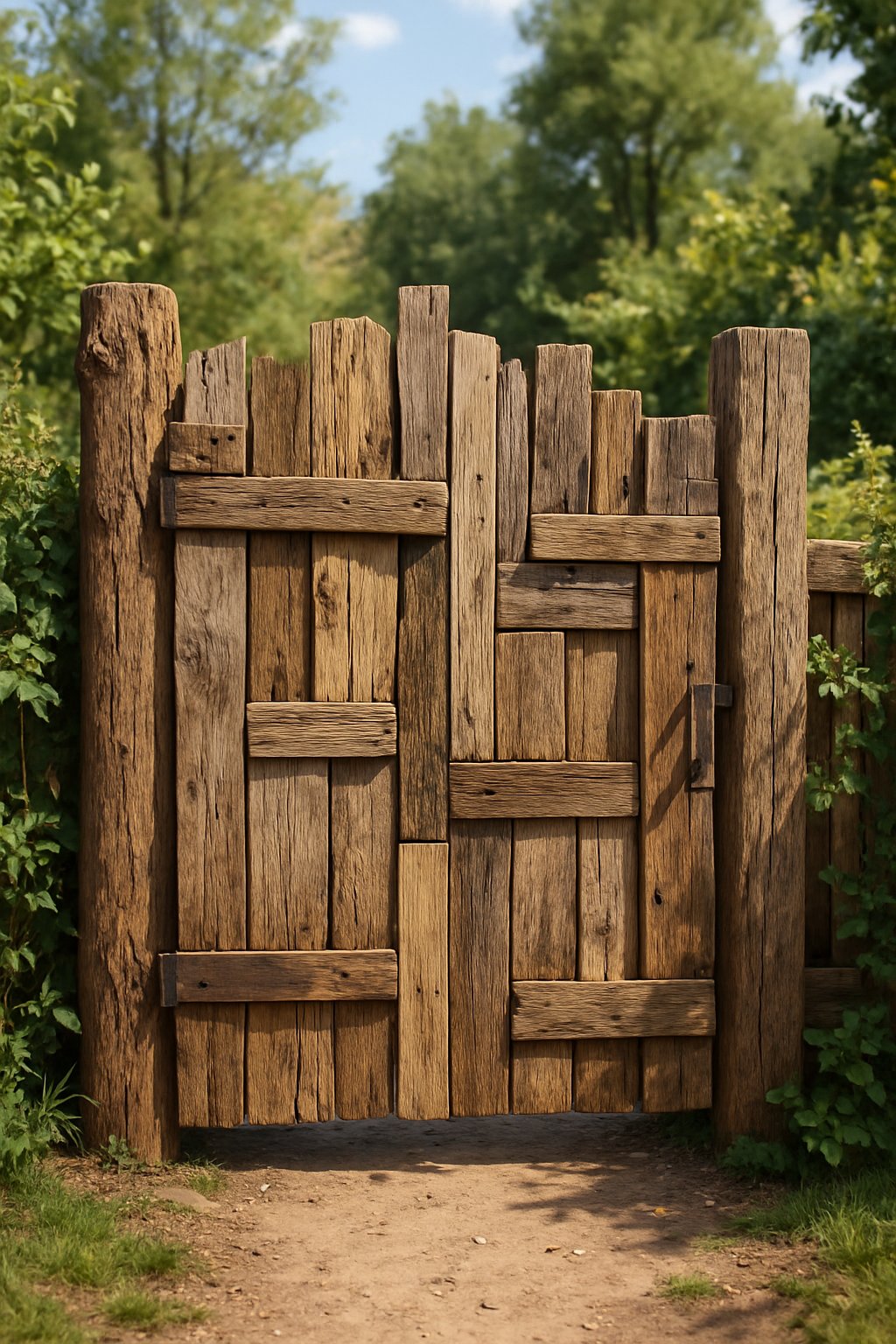
You can build a charming gate from scrap wood, which saves money and adds a lot of personality to your yard. Just start by gathering old wood—pallets, crates, leftover lumber, whatever looks solid and isn’t rotting.
Cut the wood into pieces for the frame, then fill the inside with whatever pattern you want—diagonal slats, lattice, or just simple vertical boards. Attach everything with nails or screws so it stays put.
Give the gate a quick sanding to smooth out rough edges. Slap on some weather-resistant paint or finish, and maybe a coat of sealant so it holds up outside.
This gate really suits rustic or country-style gardens, but honestly, you can make it fit your vibe. Add a handle or a latch to finish it off and make it actually useful.
Expert Tip from MrPlanter: “Always measure your gate opening first and build the frame slightly smaller for smooth swinging. Use exterior-grade screws for long-lasting durability.”
24. Door fence for garden enclosure
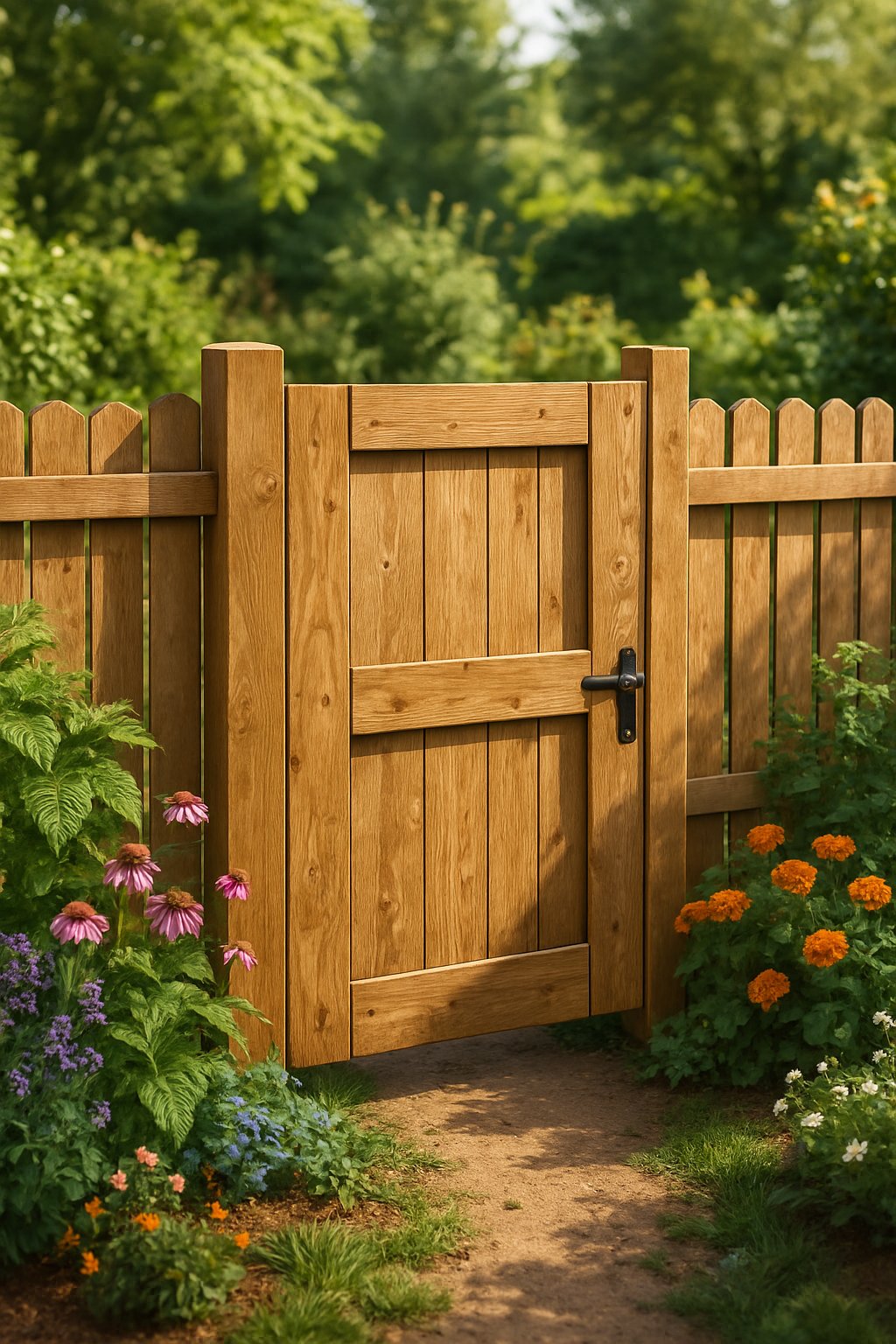
A simple door works great as a garden fence gate. You can grab an old door or pick up some wood and just build one yourself.
Cut the wood to the size you want. Then, nail the pieces together and you’ve got a sturdy frame.
Add some hinges and a latch so you can actually open and close it. That way, animals stay out and your plants stay a little safer.
You don’t need fancy materials for this. It’s honestly kind of nice how reliable and strong a homemade gate can be.
Set your door gate wherever you want easy access to your garden. If you measure carefully, it’ll fit just right.
This idea doesn’t cost much, and it adds a bit of your own personality to the yard. Feels pretty satisfying, doesn’t it?
Expert Tip from MrPlanter: “Choose weather-resistant wood or seal your door to keep it safe from rain and sun. A well-maintained door gate lasts longer and looks better over time.”

